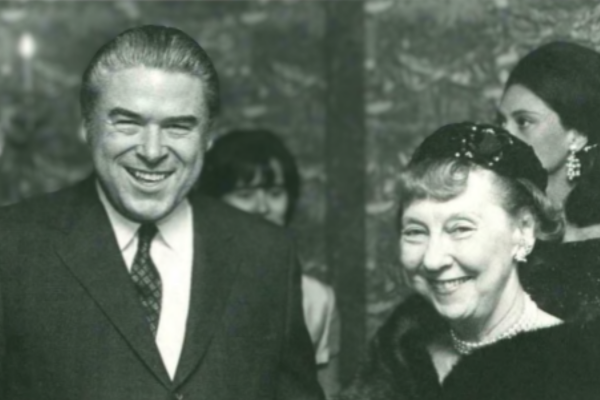February 05, 2025
Former First Lady Mamie Eisenhower with Dr. George E. Schreiner at the NKF's Annual Meeting in 1968.
Picture the 1960s. Do images of hippies, the moon landing, and civil rights marches come to mind? The '60s were a time of cultural revolution, scientific breakthroughs, and social change.
You may not know that this time also marked a turning point in kidney care.
This decade laid the groundwork for the care that millions of people receive today. The National Kidney Foundation (NKF) was there to educate the public, push for better care, and advocate for life-saving treatments.
Here's a closer look at the kidney disease milestones and NKF achievements of the 1960s.
Kidney Disease Treatment Innovations
- 1960: Researchers added Teflon to dialysis machines to stop blood clotting. Blood clots were a big problem in early dialysis. Teflon fixed this by creating a smooth, non-stick surface. It is still used in dialysis machines today.
- 1960: Dr. Belding Hibbard Scribner invented the Scribner shunt. Before this invention, people had surgery each time they needed dialysis. The shunt allowed repeated access to a patient's bloodstream. It enabled people with kidney failure to receive dialysis for much longer. Learn more about dialysis access.
- 1961: Dr. Kountz performed the first successful kidney transplant between non-identical twins. He proved transplants could work even when donors and recipients aren't perfect matches.
- 1962: The first outpatient hemodialysis center in the U.S. opened in Seattle. This center allowed people to get dialysis without staying in the hospital.
- 1967: Dr. Kountz helped create the Belzer kidney perfusion machine. This machine kept donated kidneys healthy for about 28 hours.
Subscribe today!
Join the NKF Blog Newsletter
Get inspirational stories and kidney disease resources delivered to your inbox every month. You'll gain practical insights and expert advice to help you better understand and manage your kidney health no matter where you are on your kidney journey.
Advocacy and Education
- 1964: The National Kidney Disease Foundation became the National Kidney Foundation (NKF). The new name reflected a bigger mission. The goal was to educate people about kidney health, advocate for better care, and raise kidney disease awareness.
- 1966: NKF launched its first national public education campaign. The campaign featured Bob Hope, a comedian, and Rhonda Fleming, an actress and singer.
- 1967: Governor Rockefeller approved the creation of the Kidney Institute of New York. NKF President, Dr. Jones, was present while Rockefeller signed the bill for this research and treatment center.
- 1967: The NKF's Scientific Advisory Board inspired the creation of the American Society of Nephrology, a group dedicated to kidney research.
Research Milestones
- 1967: Dr. Carl Gottschalk wanted to make treatment accessible for all patients. He released "The Gottschalk Report" which called for universal dialysis coverage. This report would help lay the groundwork for Medicare covering all kidney failure patients.
- 1968: NKF began its Research Fellowship program, awarding 13 grants to scientists worldwide. Learn more about NKF Grants or the NKF Innovation Fund.


















